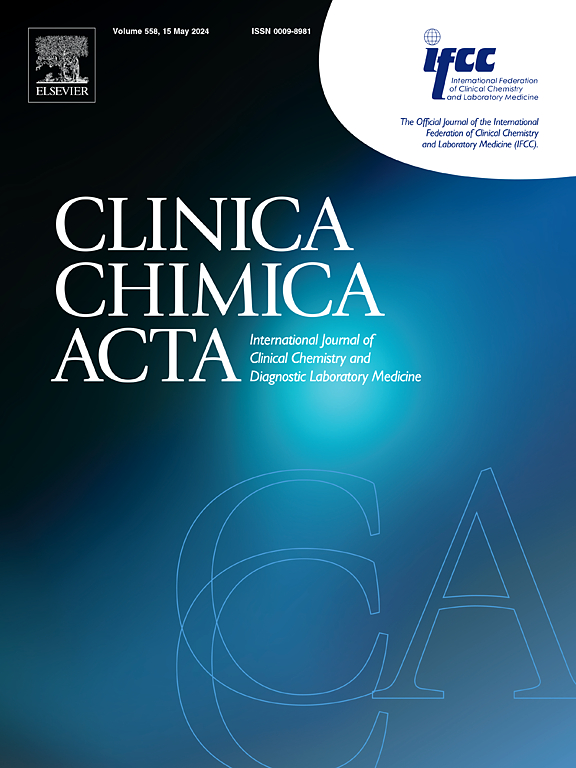Associations between biological markers and haematological manifestations in patients with systemic lupus erythematosus
IF 3.2
3区 医学
Q2 MEDICAL LABORATORY TECHNOLOGY
引用次数: 0
Abstract
Background
Haematological conditions are part of the EULAR/ACR 2019 diagnostic criteria for systemic lupus erythematosus (SLE). They consist of 4 cytopenias (haemolytic anaemia, leucopenia, lymphopenia and thrombocytopenia) which may appear at diagnosis and/or during follow-up. The simultaneous involvement of these cytopenias in the clinical and immunological management of patients with SLE is poorly understood. Therefore, the purpose of this study is to determine the overall relationships between them, as well as the individual associations of each.
Methods
Two hundred and two Caucasian patients with adult-onset SLE were studied. Medical records were reviewed from January 2005 to December 2024 and clinical and laboratory variables were collected at diagnosis and during follow-up.
Results
Eighty patients (39.6 %) had some form of haematological manifestation. Overall, haematological manifestations showed positive associations with C3 and C4 hypocomplementemia, anti-Ro/SSA antibodies and sex ratio (female/male), as well as a negative association with lupus nephritis. When analyzing the 4 cytopenias individually, surprising results were found. C3 and/or C4 hypocomplementemia was simultaneously associated with haemolytic anaemia, leucopenia and lymphopenia. Anti-double-stranded DNA antibodies were associated with thrombocytopenia (OR = 5.269, P = 0.026; multivariate analysis). Leucopenia was positively associated with anti-Ro/SSA antibodies (OR = 8.888, P = 0.003; multivariate analysis), and negatively associated with lupus nephritis (OR = 0.184, P = 0.007; univariate analysis) and lupus anticoagulant (OR = 0.132, P = 0.039; multivariate analysis). Finally, lymphopenia was associated with sex ratio.
Conclusions
Therefore, haematological conditions in patients with SLE present specific features that could represent a distinctive subtype of SLE.

系统性红斑狼疮患者的生物学标志物与血液学表现之间的关系
血液学条件是EULAR/ACR 2019系统性红斑狼疮(SLE)诊断标准的一部分。它们包括4种细胞减少症(溶血性贫血、白细胞减少、淋巴细胞减少和血小板减少),可在诊断和/或随访期间出现。这些细胞减少症同时参与SLE患者的临床和免疫管理尚不清楚。因此,本研究的目的是确定它们之间的整体关系,以及它们各自的关联。方法对202例成年起病的白种人SLE患者进行研究。审查了2005年1月至2024年12月的医疗记录,并在诊断和随访期间收集了临床和实验室变量。结果80例(39.6%)患者有不同形式的血液学表现。总体而言,血液学表现与C3和C4低补体血症、抗ro /SSA抗体和性别比例(女性/男性)呈正相关,与狼疮性肾炎呈负相关。当对4种细胞减少症进行单独分析时,发现了令人惊讶的结果。C3和/或C4低补体血症同时与溶血性贫血、白细胞减少和淋巴细胞减少有关。抗双链DNA抗体与血小板减少症相关(OR = 5.269, P = 0.026;多变量分析)。白细胞减少与抗ro /SSA抗体呈正相关(OR = 8.888, P = 0.003;多因素分析),且与狼疮性肾炎呈负相关(OR = 0.184, P = 0.007;单因素分析)和狼疮抗凝剂(OR = 0.132, P = 0.039;多变量分析)。最后,淋巴细胞减少症与性别比例有关。因此,SLE患者的血液学状况具有特异性特征,可能代表SLE的独特亚型。
本文章由计算机程序翻译,如有差异,请以英文原文为准。
求助全文
约1分钟内获得全文
求助全文
来源期刊

Clinica Chimica Acta
医学-医学实验技术
CiteScore
10.10
自引率
2.00%
发文量
1268
审稿时长
23 days
期刊介绍:
The Official Journal of the International Federation of Clinical Chemistry and Laboratory Medicine (IFCC)
Clinica Chimica Acta is a high-quality journal which publishes original Research Communications in the field of clinical chemistry and laboratory medicine, defined as the diagnostic application of chemistry, biochemistry, immunochemistry, biochemical aspects of hematology, toxicology, and molecular biology to the study of human disease in body fluids and cells.
The objective of the journal is to publish novel information leading to a better understanding of biological mechanisms of human diseases, their prevention, diagnosis, and patient management. Reports of an applied clinical character are also welcome. Papers concerned with normal metabolic processes or with constituents of normal cells or body fluids, such as reports of experimental or clinical studies in animals, are only considered when they are clearly and directly relevant to human disease. Evaluation of commercial products have a low priority for publication, unless they are novel or represent a technological breakthrough. Studies dealing with effects of drugs and natural products and studies dealing with the redox status in various diseases are not within the journal''s scope. Development and evaluation of novel analytical methodologies where applicable to diagnostic clinical chemistry and laboratory medicine, including point-of-care testing, and topics on laboratory management and informatics will also be considered. Studies focused on emerging diagnostic technologies and (big) data analysis procedures including digitalization, mobile Health, and artificial Intelligence applied to Laboratory Medicine are also of interest.
 求助内容:
求助内容: 应助结果提醒方式:
应助结果提醒方式:


